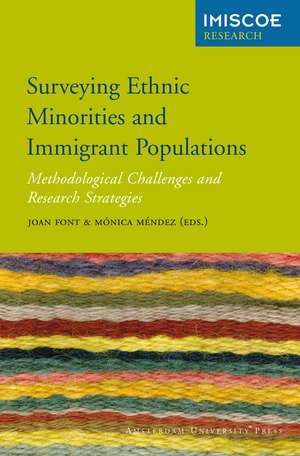Surveying Ethnic Minorities and Immigrant Populations: Methodological Challenges and Research Strategies: IMISCOE Research
Editat de Joan Font, Mónica Méndezen Limba Engleză Paperback – 17 apr 2013
What challenges do researchers face when surveying immigrant populations and ethnic minorities? What are the best ways to ensure that general population surveys adequately represent minority groups? The first book to systematically address these questions, this volume analyzes more than a dozen surveys conducted in eight Western countries on topics ranging from politics to health. These case studies—which include local and national surveys with various levels of funding—offer valuable lessons about dealing with a range of methodological challenges.
Preț: 350.91 lei
Nou
Puncte Express: 526
Preț estimativ în valută:
67.14€ • 70.29$ • 55.56£
67.14€ • 70.29$ • 55.56£
Carte indisponibilă temporar
Doresc să fiu notificat când acest titlu va fi disponibil:
Se trimite...
Preluare comenzi: 021 569.72.76
Specificații
ISBN-13: 9789089645432
ISBN-10: 9089645438
Pagini: 296
Dimensiuni: 152 x 229 x 23 mm
Greutate: 0.42 kg
Editura: Amsterdam University Press
Colecția Amsterdam University Press
Seria IMISCOE Research
ISBN-10: 9089645438
Pagini: 296
Dimensiuni: 152 x 229 x 23 mm
Greutate: 0.42 kg
Editura: Amsterdam University Press
Colecția Amsterdam University Press
Seria IMISCOE Research
Notă biografică
Joan Font is a senior researcher at the Institute for Advanced Social Studies, National Research Council, in Córdoba, Spain. Mónica Méndez is a survey methodology specialist at the Sociological Research Centre in Madrid.
Cuprins
1 Introduction: The methodological challenges of surveying populations of immigrant origin
PART I SAMPLING ISSUES
2 Designing high-quality surveys of ethnic minority groups
in the United Kingdom
3 The 2007 Spanish National Immigrant Survey (ENI): Sampling from the Padrón
3.2 International migrations and the Spanish statistical system
3.3 Role of the ENI in supplying information on international migrations in Spain
4 Enhancing representativeness in highly dynamic settings: Lessons from the NEPIA survey
PART II FIELDWORK AND RESPONSE RATES
5 The influence of interviewers’ ethnic background in a survey among Surinamese in the Netherlands
5.2 Existing research on response effects and race of interviewer effects
6 Surveying migrants and migrant associations in Stockholm
7 Comparing the response rates of autochthonous and migrant populations in nominal sampling surveys: The LOCALMULTIDEM study in Madrid
7.2 Response rates in survey research: What do we know about interviewing immigrants?
7.4 Comparing the response rates of migrant-background and autochthonous individuals 160
7.5 Does trying harder pay off? The success of refusal conversion and additional location attempts
8 Non-response among immigrants in Denmark
8.2 Hypotheses linking characteristics of sample persons and interviewers with contact and cooperation
8.3 Population sampling of immigrants and Danes
PART III INCLUDING IMMIGRANTS IN GENERAL POPULATION SOCIAL SURVEYS
9 Immigration and general population surveys in Spain: The CIS surveys
10 An evaluation of Spanish questions on the 2006 and 2008 US General Social Surveys
10.3 The 2006 GSS: Some data on the coverage of Hispanic population
10.4 Differences in socio-demographic profile of Hispanics
10.5 Differences in attitudes, behaviours and other non-demographic variables
11 Under-representation of foreign minorities in cross-sectional and longitudinal surveys in Switzerland
CONCLUSIONS
12 Surveying immigrant populations: Methodological strategies, good practices and open questions
12.2 Deciding on the target population, sampling frames and
sampling strategies
PART I SAMPLING ISSUES
2 Designing high-quality surveys of ethnic minority groups
in the United Kingdom
3 The 2007 Spanish National Immigrant Survey (ENI): Sampling from the Padrón
3.2 International migrations and the Spanish statistical system
3.3 Role of the ENI in supplying information on international migrations in Spain
4 Enhancing representativeness in highly dynamic settings: Lessons from the NEPIA survey
PART II FIELDWORK AND RESPONSE RATES
5 The influence of interviewers’ ethnic background in a survey among Surinamese in the Netherlands
5.2 Existing research on response effects and race of interviewer effects
6 Surveying migrants and migrant associations in Stockholm
7 Comparing the response rates of autochthonous and migrant populations in nominal sampling surveys: The LOCALMULTIDEM study in Madrid
7.2 Response rates in survey research: What do we know about interviewing immigrants?
7.4 Comparing the response rates of migrant-background and autochthonous individuals 160
7.5 Does trying harder pay off? The success of refusal conversion and additional location attempts
8 Non-response among immigrants in Denmark
8.2 Hypotheses linking characteristics of sample persons and interviewers with contact and cooperation
8.3 Population sampling of immigrants and Danes
PART III INCLUDING IMMIGRANTS IN GENERAL POPULATION SOCIAL SURVEYS
9 Immigration and general population surveys in Spain: The CIS surveys
10 An evaluation of Spanish questions on the 2006 and 2008 US General Social Surveys
10.3 The 2006 GSS: Some data on the coverage of Hispanic population
10.4 Differences in socio-demographic profile of Hispanics
10.5 Differences in attitudes, behaviours and other non-demographic variables
11 Under-representation of foreign minorities in cross-sectional and longitudinal surveys in Switzerland
CONCLUSIONS
12 Surveying immigrant populations: Methodological strategies, good practices and open questions
12.2 Deciding on the target population, sampling frames and
sampling strategies
Recenzii
“Even survey methodologists and researchers who are not directly concerned with immigration as such will gain from reading the book and keeping it as a reference.”






